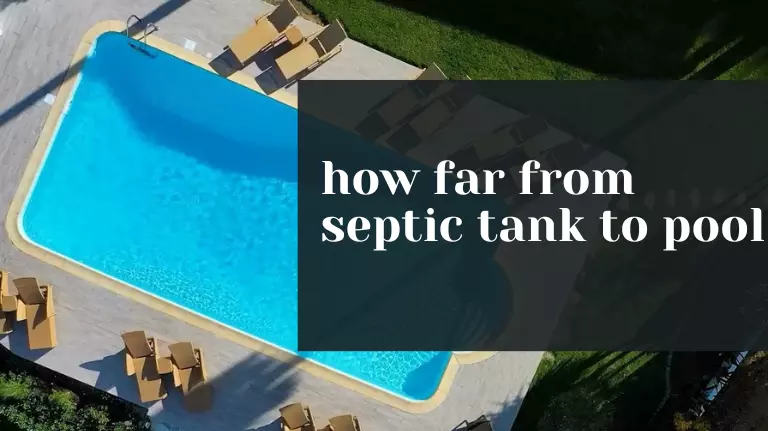If you’re considering building a pool in your backyard, it’s important to understand the regulations surrounding the placement of your septic tank. Septic tanks are a necessary component of many homes, but they can pose a risk to the health and safety of those who use your pool if they are not properly located. In this article, we will explore the regulations surrounding the placement of septic tanks in relation to pools, and provide you with some tips on how to make sure your pool is safe and healthy.
Understanding Septic Tanks
Before we can discuss the regulations surrounding the placement of septic tanks in relation to pools, it’s important to understand what a septic tank is and how it works. A septic tank is a large, underground tank that is designed to collect and treat wastewater from your home. When you flush the toilet, run the sink, or take a shower, the wastewater flows into the septic tank, where it is treated and then released into the drain field. The tank is typically made of concrete, fiberglass, or polyethylene, and can vary in size depending on the size of your home and the number of people living in it.
Why is the Location of Your Septic Tank Important?
The location of your septic tank is important for a number of reasons. Firstly, if your septic tank is located too close to your pool, it can pose a health risk to those using the pool. This is because the wastewater in the septic tank can contain harmful bacteria and viruses that can spread to the pool if they are not properly treated. Additionally, if your septic tank is located too close to your pool, it can create a foul odor that can be unpleasant for swimmers and guests.
What are the Regulations Surrounding the Placement of Septic Tanks in Relation to Pools?
The regulations surrounding the placement of septic tanks in relation to pools vary depending on where you live. In general, however, there are a few rules that you should keep in mind.
1. Distance
The first rule is that your septic tank should be located at least 50 feet away from your pool. This distance helps to ensure that any harmful bacteria or viruses in the septic tank are not able to reach the pool.
2. Elevation
The second rule is that your septic tank should be located at a higher elevation than your pool. This helps to ensure that any wastewater that is released from the septic tank flows away from the pool, rather than towards it.
3. Regulations
It’s important to note that the regulations surrounding the placement of septic tanks in relation to pools can vary depending on your local jurisdiction. It’s important to check with your local government or a qualified professional to ensure that you are meeting all of the necessary regulations and guidelines.
Tips for Keeping Your Pool Safe and Healthy
In addition to following the regulations surrounding the placement of septic tanks in relation to pools, there are a few tips that you can follow to help keep your pool safe and healthy.
1. Regular Maintenance
Regular maintenance is key when it comes to keeping your pool safe and healthy. This includes things like regularly testing the water for pH and chlorine levels, cleaning the pool and its filters, and making sure that the water is properly circulated.
2. Good Hygiene Practices
Good hygiene practices are also important when it comes to keeping your pool safe and healthy. This includes things like showering before using the pool, not allowing pets in the pool, and making sure that any children who use the pool are properly supervised.
3. Proper Chemical Treatment
Proper chemical treatment is also important when it comes to keeping your pool safe and healthy.
This includes adding the correct amount of chlorine and other chemicals to the water to help keep it clean and free of harmful bacteria.
4. Address Any Problems Promptly
If you notice any issues with your pool, such as a foul smell or cloudy water, it’s important to address them promptly. This can help prevent any potential health risks to those using the pool and ensure that it remains safe and healthy.
5. Consult with a Professional
If you have any concerns about the safety of your pool or the placement of your septic tank, it’s always a good idea to consult with a professional. They can provide you with expert advice and guidance to ensure that your pool is safe and healthy for you and your family to enjoy.
Conclusion
In conclusion, the placement of your septic tank in relation to your pool is an important consideration when it comes to ensuring the safety and health of those using your pool. By following the regulations surrounding the placement of septic tanks and following good hygiene and maintenance practices, you can help keep your pool safe and healthy for years to come.
FAQs
What is a septic tank, and how does it work?
A septic tank is an underground tank that collects and treats wastewater from your home. When you flush the toilet or run the sink, the wastewater flows into the septic tank, where it is treated and then released into the drain field.
How far should my septic tank be from my pool?
Your septic tank should be located at least 50 feet away from your pool to help prevent the spread of harmful bacteria and viruses.
Unlock Full Article
Watch a quick video to get instant access.


Social Media